南京科远HCSE系列交流伺服用户手册(V1.02)
- 格式:pdf
- 大小:2.39 MB
- 文档页数:64


ECO2WIN使用说明-简洁版深圳市步科电气有限公司目录第一部分: 特别需要注意的事项 (3)第二部分: 建立一个简单的工程 (9)第三部分: 进行简单的控制 (16)1功能介绍 (16)2 驱动器关键参数的设置 (17)电机参数设置 (17)电流环参数 (19)速度环PID调节 (20)位置环PID调节 (21)3 保存参数: (22)4 绝对位置、相对位置控制 (25)5 速度模式 (27)6 原点模式 (29)7 脉冲方向控制模式(跟随模式) (30)第四部分: 故障诊断 (34)第一部分: 特别需要注意的事项1、EC2WIN的所有文件,包装安装文件、电机参数文件、工程文件等都需要您放在英文目录下,同时必须详细阅读该手册里所有粗体或者带颜色的字体,运行电机前请确保所有连接线均正确连接到驱动器上;2、PC与ED伺服之间的连线为2、3、5脚直连线;3、如果您使用的是ED400、ED430、ED600、ED630系列的伺服驱动器,请先更新软件再进入下一步。
更新软件方法如下:把附件里的“DEV”文件夹里的两个文件解压出来,然后复制到EC2WIN的安装目录D:\Program Files\JAT\ECO2WIN\Dev里的两个文件“ENU和DEU”两个文件夹,替换以前的这两个文件即可。
4、如果您使用的3相电机,那么在新建或者连接已经建好的工程之前先用ECO2LOAD软件更新电机参数,三相电机的参数文件请参考附件,这些参数包括位置环、速度环、电流环、电机参数设置等参数,这样可以节省您设置这些参数的时间,同时也避免不小心设置成一个错误的值。
更新方法如下:1、打开“开始”菜单里的ECO2LOAD软件:2、然后进入软件界面:Write data into device:写参数到伺服驱动器;Read date out-of device:从伺服里读参数到文件Administration:管理伺服驱动器,用于重启和存储参数Load parameter list:选择读、写参数的内容,用来选择所要读取和做写入的是驱动器的哪些参数,正常情况下不用动这个按钮。
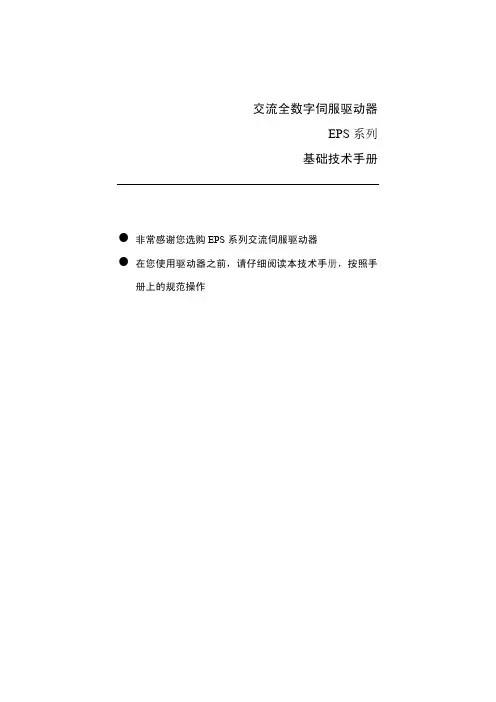
交流全数字伺服驱动器EPS系列基础技术手册z非常感谢您选购EPS系列交流伺服驱动器z在您使用驱动器之前,请仔细阅读本技术手册,按照手册上的规范操作·安全注意事项·· 安全注意事项 ·(使用前请仔细阅读)在产品的安装、运行、维护和检查前请仔细阅读本技术手册,在熟悉了有关设备的知识、安全信息和全部注意事项后再使用本产品。
请将此技术手册妥善保存,以备随时查阅。
如果您不能解决产品出现的问题,请及时联系我们。
由于产品的改进,手册内容可能变更,恕不另行通知。
在未得我公司授权下,用户对产品的改动我公司将不承担任何责任,产品的保修将因此作废。
注意下列警告,以免伤害人员、防止器件损坏。
下面的“危险”和“警告”符号是按照其事故危险的程度标出的危险指示一个潜在的危险情况,如果使用不当,会产生危险状况,有导致人员重伤甚至死亡的可能。
警告指示一个潜在的危险情况,如果使用不当,可能会产生危险状况,有导致人员受到中等程度伤害或轻伤的可能,或者发生物件损坏。
下列符号表示哪些是禁止的操作,哪些是必须遵守的。
·1··安全注意事项··2·目 录目录第一章功能和构成 (1)1.1EPS系列驱动器技术规格 (1)1.2EPS系列驱动器功能 (2)1.3EPS系列驱动器命名规则 (3)1.4EPS2系列驱动器外形尺寸 (4)1.5EPS2系列驱动器适配电机 (7)1.6各部分名称 (8)第二章安装 (9)2.1环境条件 (9)2.2驱动器安装场合 (9)2.3安装方向和间隔 (10)2.4电机的安装 (11)2.5伺服驱动器安装示意图 (11)2.6电缆应力 (12)第三章接线 (13)3.1伺服驱动器与外围设备的连接及构成 (13)3.2标准接线 (14)3.3端子功能 (17)3.4编码器信号端子CN3 (22)3.5I/O接口原理 (24)1.开关量输入接口 (24)2.开关量输出接口 (24)3.脉冲量输入接口 (25)4.伺服驱动器光电编码器输入接口 (25)5.长线驱动器(差分输出)输出接口 (26)·1·目 录3.6电源系统电路 (26)第四章参数 (28)4.1参数功能 (28)第五章监控与操作 (40)5.1面板操作 (40)5.2监视方式(DISP) (41)5.3参数设置(SET-P) (44)5.4参数管理(EEPOP) (44)5.5速度试运行 (46)第六章报警与处理 (48)6.1驱动器报警 (48)6.2报警处理 (49)第七章伺服电机 (54)7.1型号命名 (54)7.2电机安装尺寸 (57)附录 (60)·2·第一章 功能和构成·1·第一章 功能和构成1.1 EPS 系列驱动器技术规格表1.1 驱动器技术规格控制回路电源单相AC220V-15~+10% 50/60Hz主回路电源三/单相AC220V -15~+10% 50/60Hz环境温度工作:0~55 ℃存贮:-20℃~80℃ 湿度 小于90%(无结露)振动小于0.5G(4.9m/S 2),10~60Hz (非连续运行)控制方式 IGBT PWM 正弦波控制控制模式①位置控制 ②速度控制 ③转矩控制 ④位置/速度控制⑤位置/转矩控制⑥速度/转矩控制⑦内部位置控制⑧内部速度控制⑨内部转矩控制⑩试运行控制控制输入① 伺服使能 ②报警清除 ③位置偏差清零 ④指令脉冲禁止CCW ⑤驱动禁止 CW ⑥驱动禁止 ⑦控制方式选择 ⑧零速箝位控制输出①伺服准备好 ②伺服报警 ③机械制动释放 ④位置/速度到达 ⑤零速检出 ⑥转矩限制中 Z ⑦相输出 编码器反馈 2500p/r ,15线增量型,差分输出 500 p/r ,15线增量型,差分输出 通讯方式 RS232 RS485 ①② 显示与操作 ①5位LED 显示 4②个按键 制动方式 通过内置/外接制动电阻能耗制动 冷却方式 风冷(热传导膜具、高速强冷风扇) 适配电机 可通过参数设置适配不同型号电机 功率范围≤5KW第一章 功能和构成·2·1.2 EPS 系列驱动器功能表1.2 驱动器功能一览表控制功能位置控制外部输入脉冲形式脉冲/方向,CW/CCW ,A/B 两相最大指令脉冲频率 500Kpps (差分输入)电子齿轮 1/1800~1800(推荐:1/50~50)脉冲输入指令禁止信号位有效时,指令脉冲输入被禁止;可通过参数屏蔽此信号内部位置指令 16种位置设定 速度控制外部速度指令 0~±10V DC零速钳位 通过此功能使得速度保持为0 速度控制范围 1~3000 内部速度指令4种速度设定 转矩控制外部转矩指令 0~±10V DC 内部转矩指令4种转矩设定转矩控制范围外部转矩指令:0~300% 内部转矩指令:0~300%驱动禁止 当CCWL/CWL 信号有效时,电机在CCW/CW 方向输出零速保持力矩 监视功能转速、当前位置、指令脉冲积累、位置偏差、电机转矩、电机电流、转子位置、指令脉冲频率、运行状态、输入输出端子信号等保护功能 过压、欠压、过流、过速、过载、Z 脉冲丢失、编码器出错、EEPROM 错误、位置超差等报警功能 工作异常时输出报警号,同时5个LED 小数点位闪烁 信号显示 在显示部分显示外部输入、输出信号的ON/OFF 状态 增益调整 在电机运行或停止时改变增益以调节驱动器性能 报警记录可记忆包括当前报警在内的4个报警记录第一章 功能和构成·3·1.3 EPS 系列驱动器命名规则EPS □--- □ □ □ □ □ □□ (□□)专用机型电源方式{首数代表电压:2为220V ,3为380V末数代表相数:1为单相,3为三相 {1:2500p/r 2:500p/r 3:省线式} 连接方式{L:螺丝固定 }功率值{040→400W 075→750W …. 软件版本{A →通用 B →通用BT 通用 W 袜机} 2为型材散热器)例如:EPS2—TA150L123(H)注:通用A 和通用B 的区别:编码器信号分周输出脉波信号的功能不同,通用A 分频比只能取1-255整除倍脉波信号数,通用B 可以任意取输出脉波信号数。
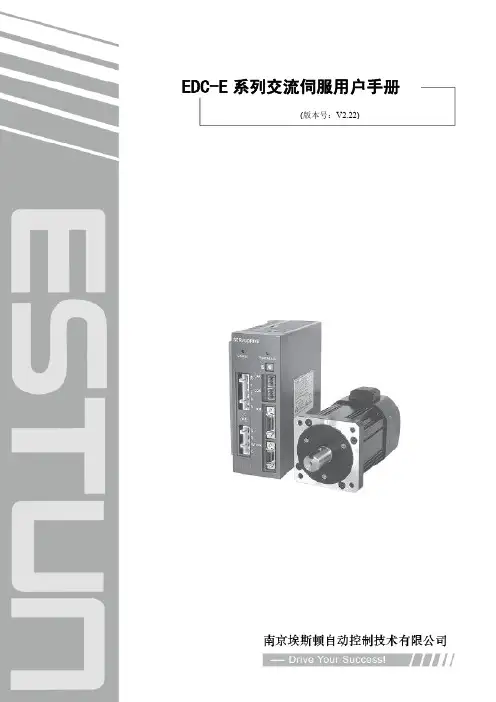
EDC-E系列交流伺服用户手册V2.22)(版本号:使用前的注意事项■EDC伺服驱动器使用的电源电压是交流220V。
请为EDC伺服系统安装交流220V±15%的电源电压。
■严禁将伺服电机与电网直接相连。
严禁将伺服电机直接与电网相连,极易损坏伺服电机,伺服电机没有伺服驱动器的支持,不能旋转。
■接通电源后禁止插、拔驱动器上的接插件。
带电插、拔极易损坏驱动器的内部电路和电机编码器,请在断电后再插、拔接插件。
■断电5分钟后才能进行伺服系统的检查作业。
即使切断电源,伺服驱动器内部的电容中仍然存储有相当的电量,为了防止触电事故的发生,建议在确认CHARGE指示灯熄灭之后,再过5分钟才能开始进行伺服系统的检查操作。
■伺服驱动器与电柜中其它设备的安装间隔需保持在10mm以上。
伺服驱动器易发热,应尽可能选择有利于散热的安装布局,与电柜中其它设备的横向间隔最好在10mm以上,纵向间隔最好在50mm以上,安装环境最好不受结露、振动、冲击的影响。
■抗干扰处理和接地。
信号线上的干扰极易造成机械的振动和运行异常,务必严格遵守如下的规定:1. 强电线缆和弱电线缆分开走线。
2. 尽量缩短走线长度。
3. 伺服电机和驱动器的安装应采用单点接地,接地阻抗在100Ω以下。
4. 伺服电机和驱动器之间严禁使用电源输入干扰滤波器。
■伺服驱动器的耐压试验应满足如下条件。
1. 输入电压:AC1500Vrms,1分钟2. 切断电源:100mA3. 频率:50/60Hz4. 加压点:R、T接头和E接头之间■漏电保护器,应使用快速反应型的漏电保护器。
使用快速反应型漏电保护器或供应商指定的PWM逆变器使用漏电保护器进行漏电保护,严禁使用延时型漏电保护器。
■避免极端的调整或变更。
不宜对伺服驱动器的参数进行极端的调整或变更,否则极易引起机械的剧烈震荡,造成不必要的财产损失。
■不要直接使用电源的通/断来运行伺服电机。
电源频繁地通/断将导致伺服驱动器内部元件迅速老化,降低驱动器的使用寿命,应使用指令信号来控制伺服电机的运行。
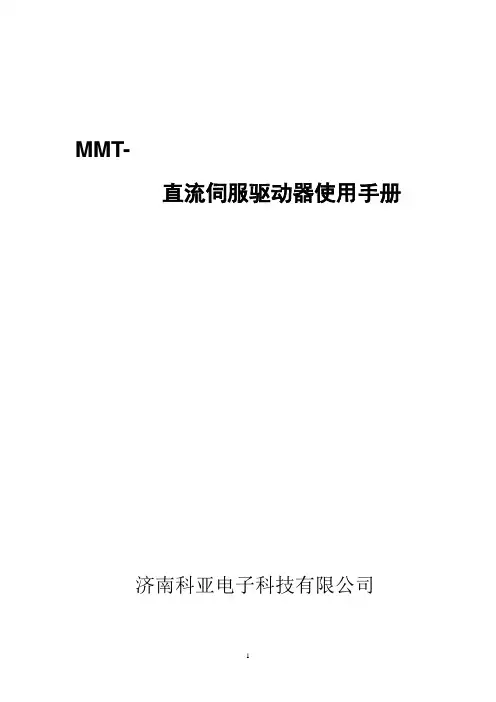
MMT-直流伺服驱动器使用手册济南科亚电子科技有限公司直流伺服驱动器使用说明书一、概述:该伺服驱动器采用全方位保护设计,具有高效率传动性能:控制精度高、线形度好、运行平稳、可靠、响应时间快、采用全隔离方式控制等特点,尤其在低转速运行下有较高的扭矩及良好的性能,在某些场合下和交流无刷伺服相比更能显示其优异的特性,并广泛应用于各种传动机械设备上。
二、产品特征:◇PWM控制H桥驱动◇四象限工作模式◇全隔离方式设计◇线形度好、控制精度高◇零点漂移极小◇转速闭环反馈电压等级可选◇标准信号接口输入0--±10V◇开关量换向功能◇零信号时马达锁定功能◇上/下限位保护功能◇使能控制功能◇上/下限速度设定◇输出电流设定功能◇具有过压、过流、过温、输出短路、马达过温、反馈异常等保护及报警功能三、主要技术参数◇控制电源电压AC:110系列:AC :110V±10%220系列:AC :220V±10%◇主电源电压AC:110系列:AC 40----110V220系列:AC50---- 220V◇输出电压DC:110系列:0—130V或其它电压可设定220系列:0—230V或其它电压可设定◇额定输出电流:DC 5A(最大输出电流10A)DC 10A(最大输出电流15A)DC 20A(最大输出电流25A)◇控制精度:0.1%◇输入给定信号:0—±10V◇测速反馈电压:7V/1000R 9.5V/1000R13.5V/1000R 20V/1000R可经由PC板内插片选定并可接受其它规格订制四、安装环境要求:◇环境温度:-5ºC ~ +50ºC◇环境湿度:相对湿度≤80RH。
(无结露)◇避免有腐蚀气体及可燃性气体环境下使用◇避免有粉尘、可导电粉沫较多的场合◇避免水、油及其他液体进入驱动器内部◇避免震动或撞击的场合使用◇避免通风不良的场合使用五、电源输入说明该驱动系统分两路电源输入:即U1、V1为主电源输入,U2、V2为控制电表1注:1、驱动器的主电源(即U1 V1)独立供电时,若电源开路时,驱动器会报警(面板上的T.F灯亮)待故障排出后,驱动器自动回复正常。
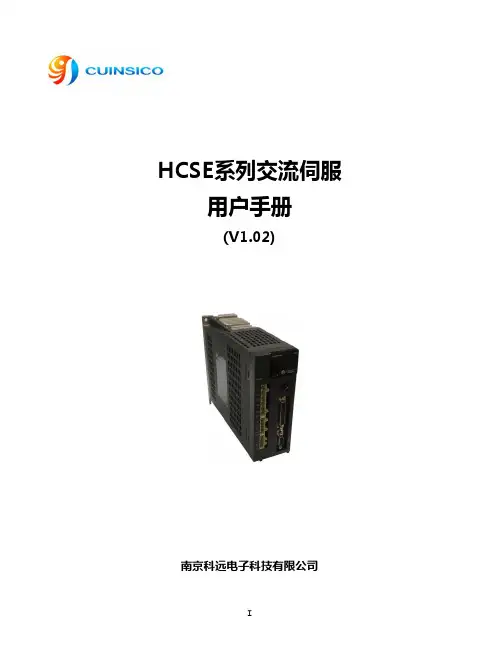
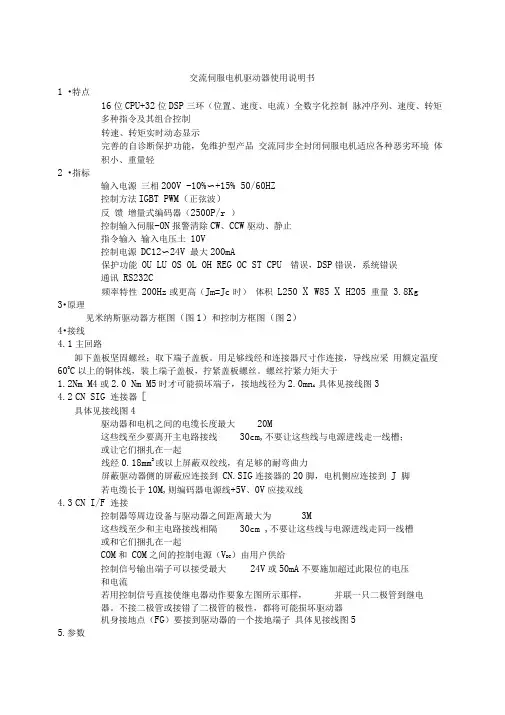
交流伺服电机驱动器使用说明书1 •特点16位CPU+32位DSP三环(位置、速度、电流)全数字化控制脉冲序列、速度、转矩多种指令及其组合控制转速、转矩实时动态显示完善的自诊断保护功能,免维护型产品交流同步全封闭伺服电机适应各种恶劣环境体积小、重量轻2 •指标输入电源三相200V -10%〜+15% 50/60HZ控制方法IGBT PWM(正弦波)反馈增量式编码器(2500P/r )控制输入伺服-ON报警清除CW、CCW驱动、静止指令输入输入电压土10V控制电源DC12〜24V 最大200mA保护功能OU LU OS OL OH REG OC ST CPU 错误,DSP错误,系统错误通讯RS232C频率特性200Hz或更高(Jm=Jc时)体积L250 X W85 X H205 重量3.8Kg 3•原理见米纳斯驱动器方框图(图1)和控制方框图(图2)4•接线4.1主回路卸下盖板坚固螺丝;取下端子盖板。
用足够线经和连接器尺寸作连接,导线应采用额定温度600C以上的铜体线,装上端子盖板,拧紧盖板螺丝。
螺丝拧紧力矩大于1.2Nm M4或2.0 Nm M5时才可能损坏端子,接地线径为2.0mn i 具体见接线图34.2CN SIG 连接器[具体见接线图4驱动器和电机之间的电缆长度最大20M这些线至少要离开主电路接线30cm,不要让这些线与电源进线走一线槽;或让它们捆扎在一起线经0.18mm2或以上屏蔽双绞线,有足够的耐弯曲力屏蔽驱动器侧的屏蔽应连接到CN.SIG连接器的20脚,电机侧应连接到J 脚若电缆长于10M,则编码器电源线+5V、0V应接双线4.3CN I/F 连接控制器等周边设备与驱动器之间距离最大为3M这些线至少和主电路接线相隔30cm ,不要让这些线与电源进线走同一线槽或和它们捆扎在一起COM和COM之间的控制电源(V DC)由用户供给控制信号输出端子可以接受最大24V或50mA不要施加超过此限位的电压和电流若用控制信号直接使继电器动作要象左图所示那样,并联一只二极管到继电器。
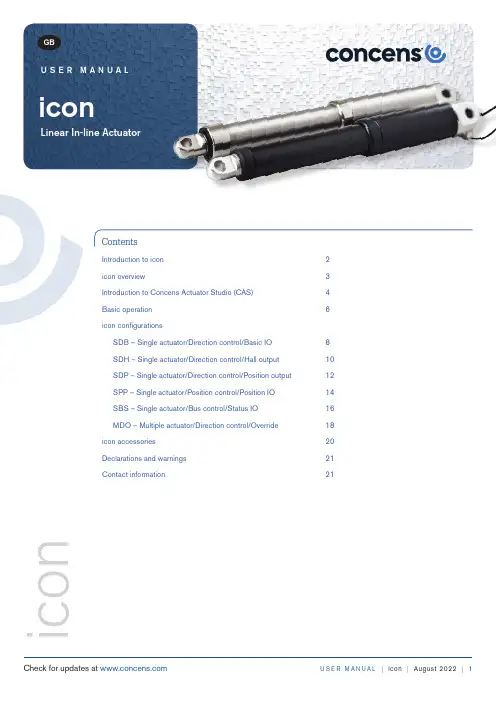
GBU S E R M A N U A LiconLinear In-line ActuatorU S E R M A N U A L | icon | August 2022 | 1i c o nCheck for updates at ContentsIntroduction to icon 2icon overview3Introduction to Concens Actuator Studio (CAS) 4Basic operation 6icon configurations SDB – Single actuator/Direction control/Basic IO 8 SDH – Single actuator/Direction control/Hall output 10 SDP – Single actuator/Direction control/Position output 12 SPP – Single actuator/Position control/Position IO 14 SBS – Single actuator/Bus control/Status IO 16MDO – Multiple actuator/Direction control/Override18icon accessories20Declarations and warnings 21Contact information21U S E R M A N U A L2 | U S E R M A N U A L | icon | August 2022i c o nF eaturesIntegrated controllerInternal stroke limitationInternal current limitation with adjustable limits Internal heat protection Adjustable start/stop ramp Modbus RTU Interface on RS485Interconnection of up to 128 units – up to 8 units synchronous Plug & Play solution with conXion Box/Box+/DINFree downloadable software – Concens Actuator Studio (CAS)icon Datasheet: https:///information/downloads/icon Quick Guide: https:///information/downloads/#manualconXion Box/Box+/DIN Installation Guide: https:///information/downloads/#manualEnsure that the actuator is fixed in both its end brackets before use, as this will result in incorrect positioning.Related documentationicon Datasheeticon Quick Guide & conXion Installation Guideicon configurationsicon actuators come in six different factory configurations as shown in the table below.For all configurations except SDH, Signal GND (pin 3) and Power GND (pin 4) must be connected at the end of the actuator cable , i.e. at the Molex Minifit jr. connector. This connection is established inside the conXion units but can be removed with a jumper. Please refer to the installation manual for further details.The numbers in the (parentheses) refer to the Molex Minifit layout.Please find further information on jumper settings for the conXion Box, Box+ and DIN versions in the conXion - Installation Guide:https:///information/downloads/#manualAll icon actuators come with an 8-pin Molex Mini fit JR connector unless specified otherwise and the connections for each configuration are shown in the table below.U S E R M A N U A L | icon | August 2022 | 3i c onUS ER M A N U A L4 | U S E R M A N U A L | icon | August 2022i c o nCAS can be downloaded free of charge from the Concens website:https:///information/downloads/#softwareConcens Actuator Studio (CAS)T o connect the icon actuator to CAS, we recommend using the Concens programming cable as shown below in conjunction with the conXion box, box+ or DIN.Programming cable CC-874-01-0000-00-00conXion BoxCC-971-07-0000-00-00conXion DINCC-971-06-0000-00-00conXion Box+CC-971-05-0000-00-00When CAS is started, it initially shows a window with information about version etc. This window closes automaticallyafter 10 seconds or can be closed manually after which the overview screen appears.The number of icons connected can be adjusted, and the number of lines shown in the overview window will change accordingly. Only one icon at a time can be active and operated in CAS. However, it is possible to see all actuators in the overview. If an actuator is recognized the uptime counter will be counting if “Active” is ticked.When more icons are connected, they must have different addresses. All single setup icons come with default address 8. This can be changed under the “Service/Config” tab. Enter new address in “Modbus address” and click “Save/Update”.Address range for single actuators is 1 to 199. Multi setup icons (MDO) are preset to addresses from 200 to 207 with 200 being “Master” (please refer to MDO section).U S E R M A N U A L | icon | August 2022 | 5i c onU S E R M A N U A L6| U S E R M A N U A L | icon | August 2022i c o nreturns the piston to the fully retracted position and stores this position as “Home” (Position 0). The Learn function runs a full cycle and determines both fully retracted and fully extracted positions of the piston. Please note that these positions may be determined by physical limitations in the mechanical design of the application and not by the end positions of the actuator.Before performing a "Home" or "Learn" cycle the actuator(s) need to be pinned or installed in both the rear and front bracket. Otherwise the piston can spin and give an incorrect result.Click the “Run Learn” under the “Service/Config” tab to perform a learn cycle. If required by the application, “Home” position can be changed to fully extracted position and, speed during learn can be adjusted. All actuators in a multi-actuator setup must be “Homed” individually.If pin 5 and pin 6 are connected to GND simultaneously for more than 10 seconds, Homing/Learning is started. During this the actuator will travel at a lower speed and it is important that neither of the brackets can rotate freely. 0-point - (Homing) and maximum stroke length (Learning) are saved during this cycle.Please note: Learn will reset settings for “Range Scale”.Performing a Learning without having access to the CAS software can be done by using either the handset or conXion Box+ by pressing and holding both in and out buttons for 10 seconds.Depending on the original setting of the “actuator homeposition” the end position will either be Retracted or Extracted after performing the Learning process.Safe zones can equally be set without having access to the CAS software by using the handset or conXion Box+. Setting the safe zone out is done by pressing both buttons for 5 seconds and then pressing out button.Setting the safe zone in is done by pressing both buttons for 5 seconds and then pressing in button.Other basic parameters that can be adjusted under the “Actuator/Parameters” tab.As a part of a learn cycle, “Safe Zone” values are default set to 50 steps (Backwards) and full stroke-50 steps (Forward). If the stroke length is entered manually, it is necessary also to enter Safe Zone values.U S E R M A N U A L | icon | August 2022 | 7i c onU S E R MA N UAL8 | U S E R M A N U A L | icon | August 2022i c o nBlock diagramA block diagram for the icon SDB configuration is shown below:12/24TX +A RX -BIconBlock Diagram SDBnot used.Signal GND (orange)is connected to GND (black)inside the iconPin numbers refer to Molex 8-pin connector. Signal GND and Power GND is connected inside the icon.Please Note:White, Brown, Blue and Orange wire have different functionality according to configuration.See Data sheet for more information.SDB has inputs for direction (in/out). Pin 5 and pin 6 are used for direction commands. They are active low and must be pulled to power GND to activate.Interconnection/Modbus controlThe icon SDB can also be controlled via Modbus with the same functions as mentioned above. More SDB icons can be connected to the same bus if they have individual addresses. If controlled with Modbus it is still possible to override with input from the handset or contacts. However, the handset or contact-set should be, either common for all icons or each would need its own.Application example with an icon connected to PLC with Modbus interface via conXion DIN:icon conXion DIN PLC with Modbus cardU S E R M A N U A L | icon | August 2022 | 9i c onU S E R M A NU AL10 | U S E R M A N U A L | icon | August 2022i c o ndocumentation for further details.Block diagramA block diagram for the SDH configuration is shown below:12/24TX +A RX -BIconBlock Diagram SDHPlease Note:White, Brown, Blue and Orange wire have different functionality according to configuration.See Data sheet for more information.SDH has inputs for direction (in/out) and two channel hall outputs. Pin 5 and pin 6 are active low and must by pulled down to power GND to activate. The hall channels at pin 3 and pin 7 are 3.3 Vpp square wave signal (max 5mA) with a 50% duty cycle and a 90˚ phase shift. Hall outputs are NPN logic TTL level.If pin 5 and pin 6 are connected to GND simultaneously for more than 10 seconds, Homing/Learning is started. During this the actuator will travel at a lower speed and it is important that neither of the brackets can rotate freely. 0-point - (Homing) and maximum stroke length (Learning) are saved during this cycle.Special function for SDH is hall output at pin 3 (hall A) and pin 7 (hall B)Interconnection/Modbus controlThe icon SDH can also be controlled by Modbus but with the same limitations as already mentioned. Y ou can add numerous SDH icons to your application if each is provided with an individual address. If controlled with Modbus it is still possible to override with an analogue input from the handset or contacts. However, the handset or contact-set should be, either common for all icons or each would need its own.Application example with an icon connected to PLC with Modbus interface via conXion DIN:icon conXion DIN PLC with Modbus cardi c oni c o nfurther details.Block diagramA block diagram for the SDP configuration is shown below:12/24TX +A RX -BIconBlock Diagram SDP Numbers refer to pin layout of the 8-pin Molex plug of the icon.Please Note:White, Brown, Blue and Orange wire have different functionality according to configuration.See Data sheet for more information.SDP has inputs for direction (in/out), and analog feedback output for position. The inputs for direction at pin 5 and pin 6 are active low and must by pulled to power GND to activate. Pin 7 is an analog output that relate to the actual position of the piston. The output has two ranges, which can be selected in CAS: 0-5 VDC and 0-10 VDC for 24 VDC icons, but only 0-5 V range for 12 VDC icons. Power GND and Signal GND must be connected at the PLC or at the end of the cable. If pin 5 and pin 6 are connected to GND simultaneously for more than 10 seconds, Homing/Learning is started. During this the actuator will travel at a lower speed and it is important that neither of the brackets can rotate freely. 0-point - (Homing) and maximum stroke length (Learning) are saved during this cycle. The "homing" process can only be performed from the CAS software.Interconnection/Modbus controlThe SDP configuration can also be controlled by Modbus but with the same limitations as already mentioned. Y ou can add numerous SDP icons to your application if each is provided with an individual address. If controlled with Modbus it is still possible to override with analog input from handset or contacts. However, the handset or contact-set should be, either common for all icons or each would need its own.Application example with an icon connected to PLC with Modbus interface via conXion DIN:icon conXion DIN PLC with Modbus cardi c oni c o nbut you are free to use other options. Please refer to the conXion Box/Box+/DIN documentation for further details.Modbus control is not recommended with the SPP configuration as the analogue input always has higher priority than Modbus commands.Block diagramA block diagram for the SPP configuration is shown below:12/24TX +A RX -BIcon Block Diagram SPPPosition is reference (0-5(10)V).Blue wire is position input.Yellow wire is signal GND.Please Note:White, Brown, Blue and Orange wire have different functionality according to configuration.See Data sheet for more information.The icon SPP has an analog input for positioning at pin 5 and a reference output at pin 7. Reference voltage is selectable via CAS, i.e. 5 or 10 VDC (5 VDC only for 12 VDC actuators). Pin 6 has combined purpose for “Position OK”, “STOP”, and “Home/Learn”. Under normal conditions pin 6 is “high” (3.3 VDC/max 5mA) when the actuator is moving. When the target position is reached it signals “Position OK” by switching to 0 V (low) and the actuator stops. In addition to this, pin 6 can also be used as an input by pulling it down to GND. This will stop the actuator. If pin 6 isconnected to pin 5 during power up the Homing/Learning cycle is activated.i c oni c o nBlock diagramA block diagram for the SBS configuration is shown below:12/24Icon Block Diagram SBScase an error is detectedand if pulled to ground anymovement is disabledPlease Note:White, Brown, Blue and Orange wire have different functionality according to configuration.See Data sheet for more information.Pin 5 (active low) is a digital stop input, which disables the motor drivers in the icon completely. Pin 6 (active high) is a fault output. Any fault detected is indicated by a change from 0 VDC to 3.3 VDC at this pin. Pin 3 is a signal GND connection.The conXion Box/Box+/DIN can be used as an interface. Please refer to the conXion Box/Box+/DIN documentation for further details.Interconnection/Modbus controlThe interconnection of icon SBS is illustrated below. Up to 10 icons can be connected in the same setup withoutadditional hardware. More than 10 units require a Modbus hub or similar.icon conXion DIN PLC with Modbus cardi c oni c o nBox/Box+/DIN documentation for further details. Each conXion needs it´s own connection to the main power supply.It is not possible to control an MDO setup via Modbus as this bus is used for synchronization purposes.Block diagramA block diagram for the MDO configuration is shown below:12/24TX +A RX -BIconBlock Diagram MDOWhite wire is used for Override.In normal state voltage level is 3.3V,when Override is activated it is pulled to ground (0V =active low)Please Note:White, Brown, Blue and Orange wire have different functionality according to configuration.See Data sheet for more information.All actuators in an MDO setup must have different addresses with the master being number 200 and slaves counting from 201 to 207. All other parameters in the icons must be identical. This is configured from factory but can be changed via CAS.Please refer to the Basic Operation section to perform Homing of the actuators and please note that all actuators in an MDO setup must be Homed individually.Pin 5 and pin 6 of the master icon are used to control the actuators out and in respectively. Both pins are active low, i.e. they need to be pulled down to GND to activate.Pin 7 is an override input (active low), which enables individual travel (adjustment) of one actuator in the setup. After activating pin 7, pin 5 and pin 6 on the specific actuator can be used to move the piston.InterconnectionThe figure below shows an MDO setup with conXion DIN units connected to a PLC using the Direction Out and Direction In pins on the master actuator. Please refer to Installation Guide for conXion Box/Box+/DIN for detailsabout interconnections etc.i c oni c o nicon Accessories - incl. Part No.conXion BoxCC-971-07-0000-00-00conXion DINCC-971-06-0000-00-00Programming cable CC-874-01-0000-00-00Handset - Online conFIGURATOR (C3/4)CC-HST-001920-011000Power supply 24VDC/2A w/cable (EU/UK/US/AU)CC-980-02-0000-00-01Concens Free Downloadable software CAS (Concens Actuator Studio)conXion cable, 0,25 m CC-875-01-0000-00-00conXion cable, 1 m CC-875-02-0000-00-00conXion cable, 5 m CC-875-03-0000-00-00conXion cable, 10 m CC-875-04-0000-00-00conXion cable, 20 m CC-875-05-0000-00-00conXion Box+ with buttons In/Out CC-971-05-0000-00-00i c o n Concens A/SOddesundvej 1DK-6715 Esbjerg NDenmark T +45 70 11 11 31E ****************VAT DK U S E R M A N U A L Contact us directly - *****************Or give us a call: +45 7011 1131Disclaimer Concens products are continuously developed, built and tested for highest requirements and reliability but it is always the responsibility of the customer to validate and test the suitability of our products in a given application and environment. Concens products must not be used in safety critical applications. We do our utmost to provide accurate and up-to-date information at all times. In spite of that, Concens cannot be held responsible for any errors in the documentation. Specifications are subject to change without prior notice.For more information, please visit our website at Recommendations and warningsWrong polarity of power supply can damage the actuator. Be sure to use a power supply, which can provide at least 150% of nominal power of each actuator. Concens is not responsible for damage or injury caused by customer modification of the default actuator parameters.。
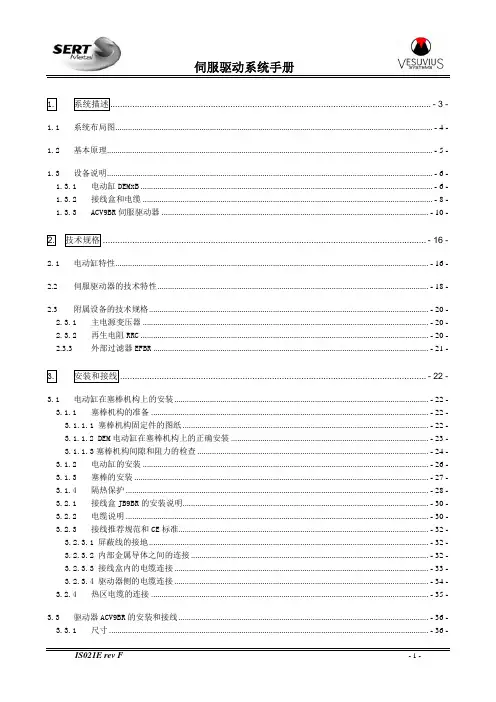
1.系统描述...................................................................................................................................- 3 -1.1系统布局图.......................................................................................................................................................- 4 -1.2基本原理...........................................................................................................................................................- 5 -1.3设备说明...........................................................................................................................................................- 6 -1.3.1电动缸DEMxB...........................................................................................................................................- 6 -1.3.2接线盒和电缆..........................................................................................................................................- 8 -1.3.3ACV9BR伺服驱动器...............................................................................................................................- 10 -2.技术规格....................................................................................................................................- 16 -2.1电动缸特性.....................................................................................................................................................- 16 -2.2伺服驱动器的技术特性.................................................................................................................................- 18 -2.3附属设备的技术规格.....................................................................................................................................- 20 -2.3.1主电源变压器........................................................................................................................................- 20 -2.3.2再生电阻RRC.........................................................................................................................................- 20 -2.3.3外部过滤器EFBR...................................................................................................................................- 21 -3.安装和接线.............................................................................................................................- 22 -3.1电动缸在塞棒机构上的安装.........................................................................................................................- 22 -3.1.1塞棒机构的准备....................................................................................................................................- 22 -3.1.1.1 塞棒机构固定件的图纸.....................................................................................................................- 22 -3.1.1.2 DEM电动缸在塞棒机构上的正确安装..............................................................................................- 23 -3.1.1.3塞棒机构间隙和阻力的检查..............................................................................................................- 24 -3.1.2电动缸的安装........................................................................................................................................- 26 -3.1.3塞棒的安装............................................................................................................................................- 27 -3.1.4隔热保护................................................................................................................................................- 28 -3.2.1接线盒JB9BR的安装说明.....................................................................................................................- 30 -3.2.2电缆说明................................................................................................................................................- 30 -3.2.3接线推荐规范和CE标准.......................................................................................................................- 32 -3.2.3.1 屏蔽线的接地.....................................................................................................................................- 32 -3.2.3.2 内部金属导体之间的连接.................................................................................................................- 32 -3.2.3.3 接线盒内的电缆连接.........................................................................................................................- 33 -3.2.3.4 驱动器侧的电缆连接.........................................................................................................................- 34 -3.2.4热区电缆的连接....................................................................................................................................- 35 -3.3驱动器ACV9BR的安装和接线.......................................................................................................................- 36 -3.3.1尺寸........................................................................................................................................................- 36 -3.3.2安装、定位和冷却................................................................................................................................- 37 -3.3.3电源的连接............................................................................................................................................- 39 -4.操作........................................................................................................................................- 40 -4.1手动模式.........................................................................................................................................................- 40 -4.2远程工作模式.................................................................................................................................................- 41 -4.3自动模式.........................................................................................................................................................- 41 -4.4塞棒关闭和安全装置.....................................................................................................................................- 42 -4.4.1塞棒关闭................................................................................................................................................- 42 -4.4.2断开电机电源(可选项).....................................................................................................................- 42 -4.5运行故障的处理.............................................................................................................................................- 43 -5.维护........................................................................................................................................- 44 -5.1检查周期.........................................................................................................................................................- 44 -5.2电动缸的检查和维护.....................................................................................................................................- 45 -5.3推荐的备件.....................................................................................................................................................- 49 -5.4伺服驱动器的故障代码.................................................................................................................................- 53 -5.5故障的数字输出代码.....................................................................................................................................- 57 -5.6驱动器复位和状态显示.................................................................................................................................- 58 -5.7没有报警显示时的故障排除.........................................................................................................................- 59 -6.辅助设备.................................................................................................................................- 61 -6.1DEM系列电动缸的测试台..............................................................................................................................- 61 -6.2塞棒机构MQS..................................................................................................................................................- 61 -1.系统描述SERT的塞棒执行器系统用于控制塞棒和塞棒机构的位置,以控制流入结晶器的钢水的流量。

※多功能低压交流伺服驱动器※KYDAS48300-1E使用手册(V2.0)济南科亚电子科技有限公司目录一.概述 (4)1、型号说明 (4)2、产品规格 (5)3、技术参数 (6)二.安装尺寸图 (7)1、平板散热 (7)2、风冷散热 (8)三.端口接线说明 (9)(1)、接线定义 (9)(2)、接口说明 (10)(3)、接线图 (12)(4)、配套线束(长0.5m) (12)四.操作说明 (13)1.上位机软件说明 (13)1.1.配置说明 (13)1.2.软件使用说明 (13)1.3.参数功能说明 (15)2.指示灯说明 (17)2.1.状态指示灯(蓝色) (17)2.2.故障指示灯(红色) (17)3.CAN指令说明 (18)3.1.通用配置 (18)3.2.指令说明 (19)3.3.CAN总线控制示例 (21)4.串口指令说明 (24)4.1.通用配置 (24)4.2.控制格式 (24)4.3.查询格式 (25)4.4.串口心跳数据 (28)五.故障保护与复位 (29)1.故障保护依据 (29)2.故障信息列表 (29)使用警告:1、初次使用应先进行相位DANGER确认,待确认相序无误后才能进行正常操作。
2、在接线有误等情况下操作电机旋转时,电机会因相位不正确而停转并发热,若持续时间过长会烧坏电机,此时应尽快关闭驱动器电源。
一.概述1、型号说明2、产品规格3、技术参数二.安装尺寸图1、平板散热注意:驱动器周围需要保留接线空间,建议>10cm、风冷散热2进风口注意:驱动器周围需要保留接线空间(建议>15cm),及良好的通风环境。
三.端口接线说明(1)、接线定义35PIN 定义1S3S32S1S13TMP-MI电机温度4+5V5Vout5F/R换向6EN使能7FLASH程序短接点8R2R29RC RC信号输入10RX-SA232—RX11JUP1120R+12CAN-L CAN-L端13编码器A-增量编码器A-14编码器B+增量编码器B+ 15编码器Z-增量编码器Z-16霍尔V+霍尔信号V+(HB+) 17SIN模拟量信号输入18GND0V19S4S420R1R121TX-SA232—TX22JUP2120R-23CAN-H CAN-H端24编码器A+增量编码器A+ 25编码器B-增量编码器B-26编码器Z+增量编码器Z+ 27霍尔U+霍尔信号U+(HA+) 28霍尔W+霍尔信号W+(HC+) 29GND0V30S2S231+5V5Vout32GND0V33+5V1RC电源34OUT数字输出35I5GND信号地(RC、232)(2)、接口说明①、TX-SA,RX-SA,I5GND:RS232通讯接口,实现指令控制,以及参数设置、运行状态调测等;另7脚FLASH与GND短接后,可用此接口烧写程序;②、CAN-H,CAN-L:CAN2.0通讯接口∙ 当11(JUP1)和22(JUP2)外部短接时,内部120R终端电阻接通;③、SIN:模拟输入接口。
![MOTEC_α系列伺服使用手册v1[1].1](https://uimg.taocdn.com/4d450783d4d8d15abe234e4e.webp)
目录HTC应用及操作概述 (1)关于本文档及相关手册 (2)HTC命名规则 (1)HTC外壳尺寸及效果图 (6)A型外壳尺寸 (6)B型外壳尺寸 (7)安装向导 (8)位置与环境 (8)在端子上接线 (8)使用接线端子连接 (11)电源安装详细说明 (12)HTC系列控制器的输入 (14)软件中的输入配置 (16)输入配线和配置 (17)保护接地 (17)电阻输入(电位计和电热调节器) (17)干接点输入 (17)0-20mA输入 (18)0-5VDC输入 (18)0-10VDC输入 (19)数字量输入 (19)二进制输出(BO) (20)模拟量输出(AO) (21)MS/TP网络配置 (22)MS/TP网络支持连接的最大设备数 (22)设定MS/TP总线MAC地址 (23)HTC应用及操作概述Hitranse公司的HTC系列控制器是一款高性能的可编程逻辑控制器,一般用来监控暖通空调设备—热泵、风机、空调、变风量(VAV)箱、空气处理设备、冷却器及类似的设备。
它们也适用于监控输入和输出控制应用的场合:例如灌溉、照明、报警监控等等。
HTC系列控制器包括带有不同I/O通道的多种型号,可以方便的满足现场的实际需求。
输入输出的电信号直接连到外部设备,且控制顺序是完全可编程的,编程使用HTVIEW系列组态软件内嵌的可视化编程环境。
编写好的程序可以通过任何一个安装有HTVIEW组态软件的工作站下载。
因为HTC系列控制器完全符合BACnet协议,所以HTC控制器中的信息和数据可以被其他符合BACnet协议(ANSI/ASHRAE标准:135-2001)的楼宇控制器访问。
也就是说BACnet兼容设备可以互相共享数据和执行命令。
关于本文档及相关手册本文件提供了关于HTC控制器的组成、安装及HTC控制器与现场设备连线等信息,HTC 连接到电源信息和通讯信息、维修和监控和HTC运行的信息。
虽然不同的HTC控制器有不同的I/O通道,但其电子特性以及基本的原理信号是相同的。
伺服拖动系统使用手册(V1.0)哈尔滨晟普科技有限公司前言感谢您购买晟普科技SP系列抽油机伺服拖动系统。
本使用说明书介绍了如何正确使用SP系列抽油机伺服拖动系统。
在使用(安装、运行、维护、检查等)前,请务必认真阅读本使用说明书。
另外,请在理解产品的安全注意事项后再使用该产品。
与安全有关的标记说明本手册根据与安全有关的内容,使用了下列标记。
有安全标记的说明,表示重要内容,请务必遵守。
表示如果操作错误,将会导致危险情况的发生,造成死亡或重伤。
表示如果操作错误,将会导致危险情况的发生,可能会造成中等程度的受伤或轻伤,或设备损坏。
另外,即使是标识中所述事项,有时也可能会造成严重的后果。
表示不属于“危险”和“注意”,但非常重要,需要用户遵守的事项。
安全注意事项⏹到货时确认◆请勿安装受损或缺少零件的伺服驱动器和电机否则会有受伤的危险。
⏹保管与搬运◆搬运伺服驱动器时轻拿轻放;运输时,确保伺服驱动器包装完好,防止振坏。
◆请勿保管在下述环境中,否则会导致触电、机器损坏或引发火灾:•阳光直射的场所•环境温度超过保管、设置温度条件的场所•相对湿度超过保管、设置湿度条件的场所•有水、油及药品滴落的场所•振动或冲击可传递到主体的场所◆请勿盘坐在本产品上或者在其上面放置重物.否则可能会导致设备故障或人员受伤◆请勿握住电缆线或电机轴进行搬运。
否则会导致设备故障或人员受伤⏹安装◆安装时请轻拿轻放。
◆只有具备资格的电气工程师才允许安装和维护伺服单元。
◆请勿将该产品安装在会溅到水的场所或易发生腐蚀的环境中。
否则可能会导致触电或引发火灾。
◆请勿将该产品安装在易燃性气体及可燃物的附近。
否则可能会导致触电或引发火灾。
◆安装过程中请勿使异物进入产品内部。
否则可能会导致故障或引发火灾。
◆请确保伺服单元与其他机器之间具有规定的间隔。
否则会导致故障或引发火灾。
◆请勿施加过大冲击。
否则可能会导致故障。
◆伺服驱动器外壳必须安全接地。
⏹配线◆请勿在伺服单元的输出端子U、V、W上连接三相AC380V电源。
汽轮机综合控制系统(DEH、ETS、TSI)用户手册南京科远控制工程有限公司目录第一章汽轮机综合控制系统技术说明书 (3)1.1系统概述 (3)1.2 DEH-NK汽轮机数字电液调节系统简述 (4)1.3 DEH-NK汽轮机数字电液调节系统的技术指标 (4)1.4 汽轮机数字电液调节系统主要功能 (5)1.4.1 DAS功能 (5)1.4.2 自动控制系统 (5)1.4.3、汽机跳闸保护系统(ETS) (7)1.4.4、汽轮机安全监测仪表(TSI) (7)1.5.DEH-NK汽轮机数字电液调节系统电子部分构成 (8)1.5.1. DEH系统的电子部分 (8)1.6.DEH-NK订货型号 (11)第二章汽轮机综合控制系统逻辑设计说明 (11)第三章汽轮机综合控制系统操作说明书 (18)3.1.DEH-NK系统主要功能 (18)3.2.DEH-NK系统设计说明 (19)3.2.1 EH油系统控制 (19)3.2.2 阀位标定 (19)3.2.3 挂闸判断条件 (19)3.2.4 远方挂闸 (19)3.2.5 启动方式选择 (19)3.2.6 转速的进行保持 (20)3.2.7 摩擦检查 (20)3.2.8 严密性实验 (20)3.2.9 超速保护实验 (21)3.2.10 自动同期控制 (21)3.2.11 功率闭环控制 (21)3.2.12 主汽压控制 (21)3.2.13 主汽压保护 (21)3.2.14 抽汽控制 (22)3.2.15 一次调频 (22)3.2.16 快减负荷功能 (23)3.2.17 协调控制 (23)3.2.18 超速保护 (23)3.2.19 活动实验 (23)3.2.20 阀位限制 (24)3.2.21 ETS保护 (24)3.2.22 TSI参数监测 (24)3.3.DEH-NK系统画面介绍 (25)3.4.DEH-NK系统的操作 (27)3.4.1 并网前操作 (27)3.4.2 并网后操作 (32)3.5 其它画面操作 (39)第四章 DEH-NK硬件介绍 (43)第五章 T2550控制器IO组态指导 (66)第一章汽轮机综合控制系统技术说明书1.1系统概述近年来随着计算机技术的发展及用户对自动化要求的不断提高,中小汽轮机(特别是抽汽机组及联合循环机组)也陆续开始应用数字电液控制系统。
南京科远D P U组态软件C C M S t u d i o使用手册-CAL-FENGHAI-(2020YEAR-YICAI)_JINGBIANNT6000V3A DCS用户手册DPU通用组态环境CCM Studio使用手册目录录 (1)概述 (1).1 主要功能 (1).2 工作模式 (1)DPU组态软件用户界面 (3).1 运行DPU组态软件 (3).2 用户界面 (5).3 软件外观 (5).4 菜单功能 (6).5 工具条 (20)DPU控制页组态过程 (22).1 DPU离线组态 (22).2 DPU在线打开、下载组态信息 (24).3 在线调试、修改组态信息 (28).4 重要操作说明 (32)1 概述1.1主要功能DPU组态软件(CCM Studio.EXE)作为NT6000系统软件的核心组成部分,主要具备以下功能:❑DPU离线组态、保存软件可对DPU的控制页进行离线组态,并保存在工程师站的磁盘上。
组态界面附合SAMA图功能块图形组态的标准。
❑DPU组态在线无扰下载,在线组态、调试可将工程师站磁盘上的组态文件下装到DPU中。
联机状态下,可以在图形组态界面上直接对DPU进行无扰组态修改、操作、调试等。
❑DPU组态文件的上载、保存可将DPU中的组态上装到工程师站并保存到磁盘上。
1.2工作模式DPU组态软件有两种工作模式:在线模式和离线模式。
在启动程序时,用户可以根据需要自行选择其工作模式。
在线模式下,组态软件自动扫描网络上可用的DPU节点,分别进行连接,并上装其组态文件;在此模式下,组态软件可以打开磁盘上保存的组态文件,并下装至DPU中。
在线模式有两种运行状态:监视状态和非监视状态,用户可以根据自己的工作需要进行选择。
监视状态下,工程师和运行人员可以监测DPU的运行情况及控制过程中各数据点的实时值;非监视状态下,工程师可以进行在线修改组态信息,并重新下装到DPU中,而无需重新启动DPU。